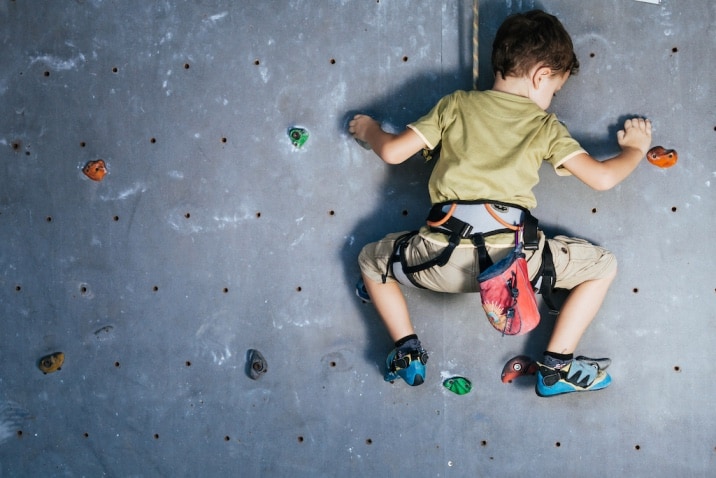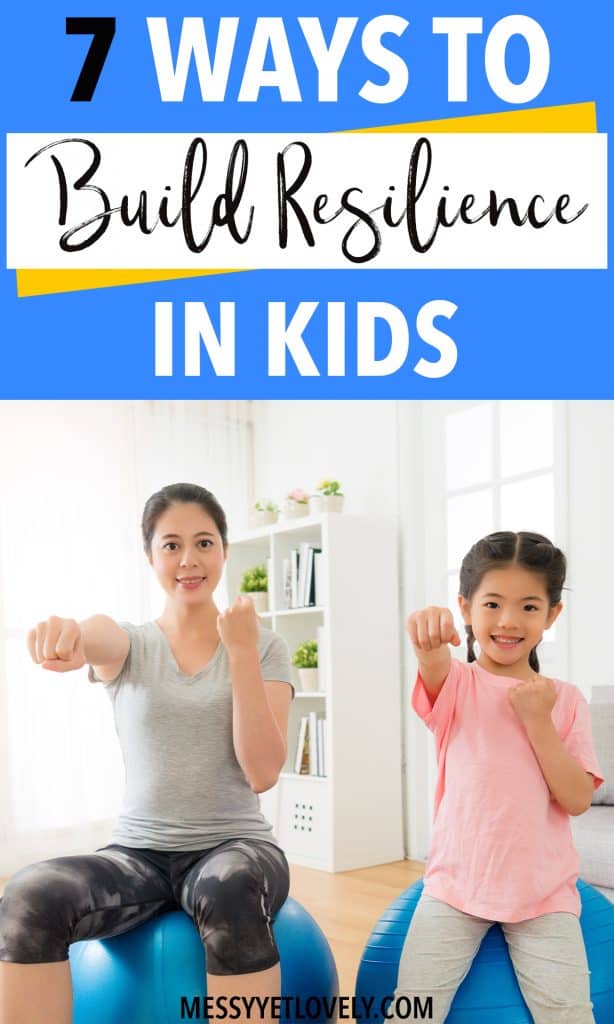Resilience means the ability to cope with misfortunes and other unplanned events in life and adapt to them.
If a person has good resilience, he will be able to adjust to the events quickly, whereas a person with less resilience becomes overwhelmed by such experiences and resort to unhealthy coping mechanisms.
And due to this reason, it’s important that children be taught resilience. Because, if their resilience is not developed, they become less ready to face the hardships in life.
As a result of poor resilience, they can develop diseases – physical and mental – and also, develop addictions to unhealthy substances as a coping mechanism.
Resilience is what helps us face unfortunate events in a positive way and rebuild our lives from the experiences we have learned.
Kids can face a lot of hardships in life like a divorce between parents, moving schools or cities, physical disabilities/illnesses, bullying, abuse, etc. Such events can make or break them depending upon how they are able to endure them.
So, how can we help children build resilience?
Let’s find out.
**This post contains affiliate links. I may receive a small commission at no extra cost to you if you make a purchase through my affiliate link**
1. HELP THEM SOLVE PROBLEMS ON THEIR OWN
How can we help kids solve problems on their own?
Answer: By helping them to think for themselves.
Parents usually jump to help kids when they try to solve a problem on their own. For example, if a toddler is trying to climb onto the sofa and if he is not able to do that, what we do is, give a little push.
Maybe the kid could have done it on his own after trying a few times. But we couldn’t help him achieve self-satisfaction by helping him. One reason parents do this is because of a lack of patience and another reason could be because we want to help them.
This might seem a small thing. But kids are small, and their problems can also seem small. And it is through practice that they can face big problems.
And also, stop trying to give solutions to their problems. Instead, ask them questions like,
“What do you think is the best possible way to solve this problem with Andy?”
“You are repeatedly having trouble with doing homework on time. What do you think you should do to get it done every day without anyone telling you?”
If necessary, you can hold a brainstorming session where you write down what the child suggests as solutions. And pick the best ones to solve the situation. This increases their confidence and also expands their thinking abilities to come up with ideas.

2. TEACH COPING SKILLS
It’s important we teach coping skills to kids because people who are not able to cope with stress may learn avoidance to deal with a problem.
Kids avoiding learning a subject, because it’s hard, is a case of avoidance. They avoid it because they don’t know a better way of dealing with the problem.
Trauma and other setbacks experienced in childhood are said to be a leading cause of addiction to alcohol and drugs. Therefore, teaching better coping skills is important.
The following are some ways to teach coping skills.
- Teach deep breathing and meditation
- Help them start a journal to write about what’s worrying them
- Discuss all kinds of emotions in a positive way. Label their emotions as ‘angry’, ‘sad’, and ‘frustrated’. Accept their emotions and do not yell at them for expressing anger
- Let them know frequently that you are always there for them no matter what happens. And tell them it’s okay to seek the help of a trusted adult for any problem they think they can’t handle themselves.
- Tell them if they feel sad about an event that happened in the past, they can feel happy again by doing the things they love (like playing with a friend, coloring, reading, cooking, getting outdoors, dancing, etc)
- Let them express anger and hurt through safe methods like hitting a pillow or punching a soft toy
Related:
- How to teach kids to regulate their emotions
- 101 simple calm-down strategies for kids to help them regulate their emotions
- 15 incredibly fun self-regulation games for kids
3. LET THEM TAKE RISKS
To help develop resilience in kids, it’s good for them to go out of their comfort zones.
Because when they are out of their comfort zone, they need to take action and face the fears that they are not used to dealing with. This helps them build coping skills as well as strength to face adversities.
What are some ways to encourage healthy risk-taking and getting out of their comfort zones?
- Encourage them to take part in sports activities like hiking, trekking, skiing, etc. Make it a family adventure so that kids feel supported.
- If you think your kids have a special talent in any field, pave way for them to learn and participate in those activities. Children may not know what they like or not. Gently force them to do activities that are out of their comfort zones. Tell them they don’t have to do it again if they hated the experience. Who knows? They might end up loving the experience too.
The point is, by helping them walk through paths that they are not used to, they face different emotions and develop the skills to face them too. These experiences get etched in their brains and they know they can overcome a struggle because they have faced “so and so” in the past.

4. TEACH THEM TO LOOK ON THE BRIGHTER SIDE
The biggest asset one can have to push through life’s struggles is a positive mindset. And therefore, it is absolutely necessary to develop a positive mindset in kids.
It is said that every experience we humans have on earth is for a higher purpose that we can’t see yet. Our misfortunes always teach us something and leave us stronger.
Teach kids about gratitude and every time they face a struggle, look for a positive and show them how they are benefitting from it.
For example, if they face bullying at school, first and foremost, take the necessary actions to stop it.
And you can say to them like this,
“I know this is a hard experience for you. But can you see that this experience taught you something?
This taught you about how you are worthy of love and respect and also how you need to stand up to people who behave badly to you.”
Experiencing trauma is never easy, but studies show that we can develop a renewed sense of gratitude and strength toward life after such experiences.
5. TEACH REFRAMING AND OPTIMISM
Like looking for the brighter side in any unfortunate event, reframing can also help to change limiting beliefs and negative thought patterns that make them prevent from taking action.
Examples of limiting beliefs and negative thoughts:
-I failed in math so I am not smart enough
-I made a terrible mistake so I don’t think anyone likes me now
Such thoughts when repeated enough times become strong beliefs and self-fulfilling prophecies.
It is important that kids learn to bounce back with optimistic thinking about how they can improve in the future rather than burying themselves under the shame of past mistakes.
And parents also need to be careful of what they say to kids so that they don’t aggravate the negative beliefs that kids already accumulate after such events.
To understand if kids suffer from such insecurities, connect with them and talk to them on a daily basis.
And help them reframe such thoughts. Here again, problem-solving skills can help.
Different beliefs require different kinds of thinking.
For example,
If a child starts to believe he is bad because of something he did, you can help him reframe his beliefs by saying,
“It’s true that you made a mistake. But your mistakes helped you learn a lesson. Now you know something that you didn’t before. Isn’t it great that you can now choose “not to do it” because you know where that path leads to?
You can now, in fact, become a better person because of the lesson you learned.”
Another example.
If a child starts to believe he is not good at something because he failed at it, use the following script.
“Failure hurts. But it’s not because there’s something wrong with you. It’s because your skills were not enough to have passed. And you know what? You can always improve your skills with practice. If you are going to set your mind to it and work hard, you will do better.
I am here to help you with what you need.”
Helping kids develop a growth mindset is crucial to develop optimistic thinking toward life.
6. TELL THEM IT’S OKAY TO ASK FOR HELP
So often, kids endure struggles and negative feelings because they don’t know how to ask for help.
I remember how I endured certain negative things in my childhood because I was so afraid to speak up and also experienced shame.
It still hurts me today that I could never speak for myself and had to battle difficult emotions in silence.
Having had this experience, I have decided that my own children would not go through this.
So I always try to listen with empathetic ears when they talk about their worries (without judgment, ridicule, belittling, and blaming).
It is important because if they want to be able to open up to you, they should feel that their emotions are always welcomed no matter how hard it is. And when they look sad, I always enquire what happened to them.
I want them to know that I am here if they need help.
Being resilient means they can bounce back easily from negative events. That doesn’t mean kids have to endure everything on their own. Human beings are wired to seek emotional support from their tribe.
So when they have help, it increases their confidence in bouncing back from hardships easily.
7. GET THEM TO PLAY OUTDOORS
Research shows that unstructured outdoor play has a significant role in developing resilience in kids. Today, kids are given fewer and fewer opportunities to play outside due to the fear of strangers.
As a result, kids are bored, and often screen time replaces the valuable lessons they can gain from outdoor play.
Playing in nature helps kids become curious about the world around them. It stretches their sense of wonder and encourages them to ask questions.
When they make mud castles, they are also teaching themselves problem-solving. Because, if they are not able to make the mud stick together, they need to think about what to do to make it sticky.
They learn to think for themselves and solve problems independently.
If you are lucky, you can find parks that offer such unrestricted play in your city. Do a quick Google search. Here is a list of parks in the US that offer unrestricted play spaces.
Related: 19 incredible benefits of nature play in children’s growth and development
More parenting posts:
- What every daughter needs from her mom
- How to discipline kids without breaking their hearts(15 positive discipline techniques that work)
- How to teach positive affirmations to kids
- How to raise grateful kids instead of complaining ones
- Top 12 skills to develop to be a good parent
Like this post? Please take a moment to PIN and SHARE!

